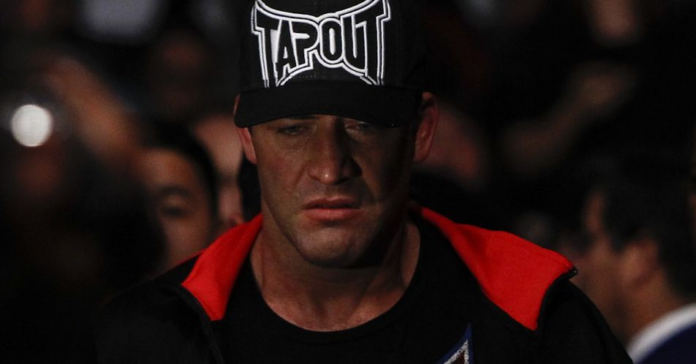If only wealth in this life were measured by the mark one leaves on the world around them, Stephan Bonnar would have been one of the wealthiest MMA fighters to ever do it.
By now, the shock has worn off. Bonnar, a beloved pioneer of MMA’s old-school — a 15-fight UFC veteran, The Ultimate Fighter finalist, and UFC Hall of Famer — died this past Thursday, leaving behind him a community in mourning and a sport swiftly becoming far too fluent with the language of unexpected loss. According to a UFC statement, Bonnar passed away due to presumed heart complications while at work. He was just 45 years old.
The word “legend” gets thrown around often these days, but with Bonnar, it is deserved. He was an original, an irreplaceable cog who played a pivotal role at one of the most pivotal times in the sport’s history. There are few fighters to whom MMA owes an eternal debt of gratitude. “The American Psycho” is one. Without hyperbole, he helped change the game forever. Because, in truth, there is a very real chance none of this exists today without him.
There is a reason UFC president Dana White, for all his bombast and revisionism, has long regarded Bonnar as being one-half of the most important fight in UFC history. When he made his octagon debut in 2005 with an all-time classic alongside Forrest Griffin, the notion of the UFC becoming a $4 billion international behemoth was ludicrous beyond reason. MMA was on life support in North America. The ownership triumvirate of White and the Fertitta brothers, Lorenzo and Frank, had lost millions upon millions of dollars in their five-year stewardship with the failing brand. The end was nigh, and the UFC needed a miracle.
Bonnar and Griffin were that miracle.
The lovable everymen who saved the day at the eleventh hour.
For a sport still haunted by accusations of “human cockfighting,” the affable light heavyweights became a guiding light when The Ultimate Fighter hit airwaves in 2005, two college-educated friends whose wit, intelligence, and charm put a more relatable face to an industry mired in claims of barbarism. TUF is often credited with salvaging a dying UFC — and it certainly kick-started the process of dispelling stigmas about MMA that had long poisoned the well of public discourse — but the reality is that Spike TV had yet to sign on for a second season by time April 9, 2005 rolled around. Had there been any other pairing in that first finale, had it been either of the show’s other semifinalists — Mike Swick or Sam Hoger — in Bonnar’s place, there’s a good chance the UFC’s first-ever event to air live on television would’ve failed to deliver the Hail Mary the moment demanded.
But MMA needed a savior, and it lucked in to the perfect two.
Seventeen years later, the back-and-forth roller-coaster of Griffin vs. Bonnar 1 still holds up.
In the sport’s first true mainstream moment for the North American audience, Griffin won the first round, Bonnar captured the second, and the third round was even, with Griffin eking out a win over the final minute in a decision that could’ve gone either way — all while live viewership numbers skyrocketed. Here were two regular men with regular jobs baring their souls on national television in a gladiatorial effort to change their lives forever.
How could you not be captivated?
Spike TV signed on for a second season of TUF that very night, before officials even left the arena, then signed the UFC to a long-term broadcast deal shortly after. One week later, with the buzz of Bonnar and Griffin’s heroics still bouncing around the mainstream ecosystem, UFC 52 set a new mark for the company’s live gate and shattered its buyrate record with more than 280,000 buys on pay-per-view. The rocket ship was strapped in and gassed up.
Bonnar’s loss had become the sport’s gain — and the UFC never looked back.
The end was nigh, and the UFC needed a miracle. Bonnar and Griffin were that miracle.
“It was kind of a little lesson,” Bonnar reflected in 2021. “If you never quit, you really can’t fail. That was the perfect example of that. Give it everything you’ve got and something good will come out of it.”
The cold reality is that MMA is a sport with no sense of its history, especially for fighters who never capture a major title. And sadly, Bonnar did not get to enjoy the fruits of his labor as much as others in that early orbit. He remained a fan favorite throughout the rest of his seven-year UFC run, and even had a co-starring role commentating some of the most iconic moments in MMA history with the WEC. His incredulous call of Anthony Pettis’ Showtime Kick on Benson Henderson in the waning minutes of WEC 53 remains one of the best ever. He fought former and future champions alike — Griffin, Rashad Evans, Jon Jones, Mark Coleman, and Anderson Silva — and though he transitioned in his post-UFC run toward pro wrestling, it is no secret that the last few years of Bonnar’s life were difficult.
MMA is not kind to its fading legends. There is no pension fund in retirement, no health insurance, no umbrella to fall back on for whatever is next. Unfortunately, Bonnar lived that firsthand. But his legacy is still one that transcends wins or belts or money. He is a seismic part of the sport’s fabric, a main player in the book of MMA, one of few fighters who can take direct credit for the sport finding its mainstream life. Multiple generations of fans and fighters today can still trace their fandom back to that fateful television debut.
Stephan Bonnar may be gone too soon, but the responsibility now falls upon all of us to ensure his memory isn’t soon forgotten.
After all he gave to MMA, it’s the least we can do.



